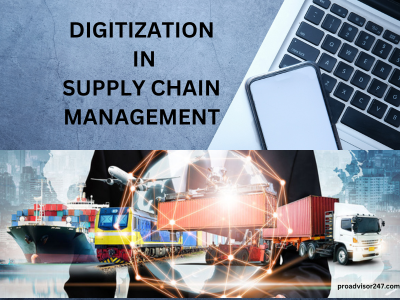
A crucial discipline called Supply Chain Management (SCM) coordinates the smooth transfer of products, services, and information from suppliers to final customers. To increase productivity, cut expenses, and increase customer happiness, it comprises strategic planning, coordination, and optimization. Digital supply chain management in the use of advanced technologies and better insights into the functions to let each stakeholder make better decisions about the sources of materials or products they need.
SCM makes use of cutting-edge technologies like data analytics, IoT, and AI to increase visibility and responsiveness. Companies can achieve operational excellence and acquire a competitive edge in today’s dynamic and interconnected business environment by reducing procedures and encouraging collaboration.
Digital Supply Chain
- Digital Supply Chain Management is comprised of the electronic technologies and tools organizations use to support their supply chain from end to end.
- The digital transformation of a supply chain involves leveraging technology to improve performance.
- Supply Chain Digital Transformation helps businesses revamp their processes and practices.
Also, learn more about What Is Intelligent Automation & An Executive’s Guide.
Digital Technologies That Transform Supply Chain Operations
- IoT Tracking Solutions
- Remote Collaboration Platforms
- Machine Learning
- Enterprise Resource Planning Software
- Warehouse Management Systems
- Robotic Process Automation
- Blockchain
- On-Demand Warehousing
Step By Step Process To Supply Chain Digitization
Step 1 – Define a vision
Step 2 – Unify Data and Processes
Step 3 – Automate the Planning Process
Step 4 – Use Data and Analytics
Step 5 – Align People with Processes
Challenges For The Digitalization Of Supply Chains
- The main internal challenge of businesses related to digitalization is the inflexibility to use of the
technologies and other hurdles to the implementation of digitalization come from skill gaps,
unclear goals, unstandardized processes, and disparate systems. - The cost and time of integrating the SCM platform with informational technology is often more.
- It is difficult to select the right kind of vendors, tools, and solutions with relevant value and integrate the system with existing systems and processes.
- The main challenge of global retailers is difficulty in managing risks related to cyber security and data breaches since there is a great number of transactions every day.
- The weakest supply chain links are targeted by attackers, which will have the greatest negative
impact on business performance and customer experience for the clients.
Business Benefits Of Digital Supply Chain
1. Cost Reduction
- Improved delivery performance.
- Improved manufacturing and design flexibility.
- Sourcing flexibility and supply chain resilience.
2. Flexibility Increase
- Net working capital reduction.
- Manufacturing cost reduction.
- Transport cost reduction.
- Material cost reduction.
- Improved asset utilization.
3. Speed Of Adoption
- Fast response time and speed of supply chain adoption.
- Real-time response on deviations.
To Know More About What Is Azure IoT And It’s Services, Click HERE.
Scope Of Project Management In SCM (Supply Chain Management)
- Project management skills can help Supply Chain Managers be more flexible and adaptable, and Supply Chain Management skills can help Project Managers mitigate risks and be more resilient.
- SCM adoption in a project-based environment brings substantial benefits but requires careful planning and execution.
Goal Of Project Management In SCM
In simplest terms, The following difficulties are what supply chain management aims to solve:
1. To get the right stuff
2. In the right quantity
3. To the right place
4. At the right time
5. The lowest total cost
Key Processes In SCM
The Supply Chain Operations Reference (SCOR) Model illustrates the six groups of processes that are key to managing the supply chain in any company:
• Plan: Develop your supply chain strategy and forecasts.
• Source: Build and manage relationships with suppliers.
• Make: Assemble products and create service capabilities.
• Deliver: Take and fill orders from customers.
• Return: Build and manage a reverse supply chain.
• Enable: Manage all of the additional processes, including project management.
Supply Chain Methodology In Project Management
The purpose of developing this methodology is to customize the methods to maximize the benefits of Project Management.
DARER Project Management Methodology
Phase 1: Project Initiation
- Define Mission Statement and key deliverables
- Agree on Cost and Timeline
- Buy-in Management Approval
- Align Resources & Deliver ables
- Create a Project Team
Phase 2: Project Execution
- Align-KPIs
- Analyse Current Status
- Map and document current processes and performance
- Develop Change Management Strategy
- Develop Contingency Plan
- Design and Develop Solution
- Implement the Solution
Phase 3: Control & Reengineer
- Project Audit
- Customer satisfaction feedback
- Identity areas for further improvement
- Develop Strategy and Solution
- Execute the solution to address the limitation
Benefits Of Project Management in SCM
- Implementing SCM-related strategies creates value and improves project performance.
- Supply chain management skills can help project managers mitigate risks and be more resilient.
- One of the main advantages of supply chain management is that projects have software and performance metrics that allow them to make meaningful decisions when it comes to choosing their suppliers or vendors.
- Supply chain management directly impacts the quality of the project and services which are
produced keeping global CSR standards and guidelines in mind.
In conclusion, Supply Chain Management is a vital discipline that promotes effectiveness, teamwork, and agility in the flow of products, services, and information delivery. Businesses can achieve cost-effectiveness, customer happiness, and competitive advantage by optimizing processes and embracing innovative technology, ultimately leading to success in today’s dynamic global economy.

